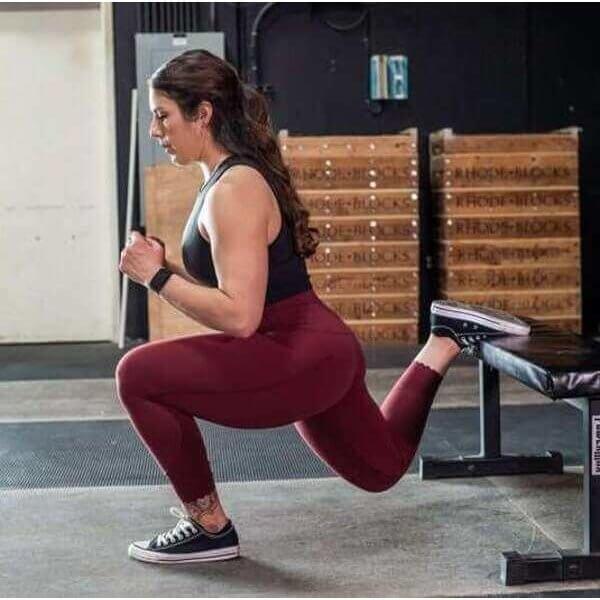
Bulgarian Split Squats: Unlocking Bigger Glutes
Share
Bulgarian Split Squats for Bigger Glutes
Transform Your Glutes with Bulgarian Split Squats: This lower body exercise primarily targets hamstrings, quadriceps, glutes, abductor muscles, and calves.
Whether you're a fan of squats or not, many of us struggle to discover new leg day exercises. Fortunately, we're here to assist you! You've probably heard of the traditional split squat, but have you tried the Bulgarian Split Squat?
It's a relatively simple and enjoyable lower-body exercise that guarantees results, especially when you incorporate a pair of dumbbells. If you're aiming for stronger glutes and a toned lower body, you'll love Bulgarian split squats. Let's get started!

Understanding the Bulgarian Split Squat
The Bulgarian Split Squat is a fantastic squat variation in which one leg is elevated while the other performs the squat. This single-leg unilateral exercise targets the leg muscles in a unique way, making it ideal for intermediate to advanced athletes with good body control and awareness.
Bulgarian Split Squat vs. Lunge
Compared to a standard lunge, the Bulgarian Split Squat is gentler on the back. So, whether you have back pain or not, it's an excellent addition to your routine. Additionally, it allows for greater depth, which can enhance hip flexor flexibility and increase your range of motion.
Muscles Worked During Bulgarian Split Squats
The Bulgarian Split Squat is a compound lower-body exercise that primarily targets the hamstrings, gluteal muscles, quadriceps, abductor muscles, and calf muscles. It also engages the abdominal muscles and spinal erectors.

Benefits of Incorporating Bulgarian Split Squats
Let's explore some of the outstanding benefits of this exercise:
Targets More Than Just Your Glutes
Since it's a single-leg exercise, you must engage your core to maintain balance. It also activates stabilizing muscles like your quads and calves.
Easy to Learn
Bulgarian Split Squats are beginner-friendly and require minimal equipment. If you lack a bench, a chair or raised platform works just as well. It's essentially an advanced lunge, making it simple to master once you have the equipment.
Builds Strength and Enhances Balance
This squat variation promotes muscle growth, increases your range of motion, and significantly improves balance. With proper form, you can add weights for enhanced core and glute activation. Compared to traditional lunges, Bulgarian split squats excel at building strength.
How to Perform Bulgarian Split Squats
Start by standing about two feet in front of a sturdy bench or chair, with your feet hip-distance apart. Engage your core, keep your shoulders back, and direct your chest and eyes forward. Lift your right foot and place it on the bench behind you. You have two options for foot placement: flex your ankle and balance on the ball of your foot and toes, or place the top of your rear foot flat on the bench with your ankle joint aligned roughly with the edge of the bench.
Slightly bend your left knee and allow your right rear knee and ankle to naturally bend during the exercise. Ensure your weight is evenly distributed across your left foot as you squat down. Inhale as you descend and exhale as you return to the starting position, using your left quad and glute to power the upward phase.
Tweaking Your Form for Specific Goals
You can target different parts of your legs depending on your body positioning and weight placement:
Targeting the Quadriceps
Stand closer to the elevated surface to emphasize your quads. However, be cautious, as this may require more balance and could strain your knees if done incorrectly.
Targeting the Core Muscles
If you're aiming to work your abs, hold weights above chest level to increase the strain on your abdominals.
Common Mistakes to Avoid
Here are some key mistakes to steer clear of when performing Bulgarian Split Squats:
Avoid lifting the front heel, as it can disrupt your balance and harm your leg muscles. Keep your front foot flat on the floor with your heel grounded throughout the exercise.
Don't rely too much on the back leg; this exercise should primarily engage your front leg, with the back leg providing support. Remember to bear most of your weight on the front leg to prevent injury.
Steer clear of leaning forward during the squat. Maintain an upright upper body throughout the movement. If you find yourself tipping forward, adjust your leg positioning or reduce the weight. Also, focus on moving back diagonally toward the rear foot, rather than straight down like a traditional squat.
Lastly, avoid using an excessively high surface to elevate your back foot. There's no need to go higher than an average bench height, as elevating too much can lead to unnecessary knee joint strain.
